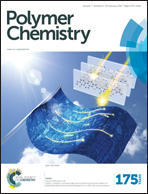Inherent flame retardation of semi-aromatic polyesters via binding small-molecule free radicals and charring†
Abstract
Inherent flame-retardant semi-aromatic polyesters, containing special aryl ether and/or ketone structures (“Ar–CO–Ar”, “Ar–O–Ar”, “Ar–O–Ar–O–Ar” or “Ar–O–Ar–CO–Ar–O–Ar”) were synthesized successfully. Interestingly, these polyesters show different flame retardancy beyond our traditional knowledge that more benzene rings are beneficial to flame retardancy. The polyester containing “Ar–O–Ar–O–Ar” shows excellent flame retardancy, whose LOI value reaches 34.1% and the UL-94 rating is V-0. Meanwhile, the polyester with the “Ar–O–Ar–CO–Ar–O–Ar” structure does not perform expectedly well (31.6% and V-2 rating respectively). In order to make clear the effect of aryl ether and/or ketone structure units on the flame retardancy, the pyrolysis behaviours and the char residue are investigated by Py-GC/MS, TGA, and SEM. In the TGA test, the char residues of polyesters containing “Ar–CO–Ar”, “Ar–O–Ar” “Ar–O–Ar–O–Ar” or “Ar–O–Ar–CO–Ar–O–Ar” are 31.6%, 22.5%, 30.6% or 38.7%, respectively. These values do not match with the calculated results, which indicate that some special reactions occur during combustion. Furthermore, these polyesters show a common initial pyrolysis pathway and subsequent unique processes in the Py-GC/MS test. Their pyrolysis intermediate products can bind small-molecule free radicals, and eventually form different conjugated aromatic structures. In this way, inherent flame-retardant polyesters are obtained even without any traditional flame-retardant elements. And their flame retardant performance has great relationship with the amount of char formation, the microstructure of char, and the chemical structure of pyrolysis products.


 Please wait while we load your content...
Please wait while we load your content...